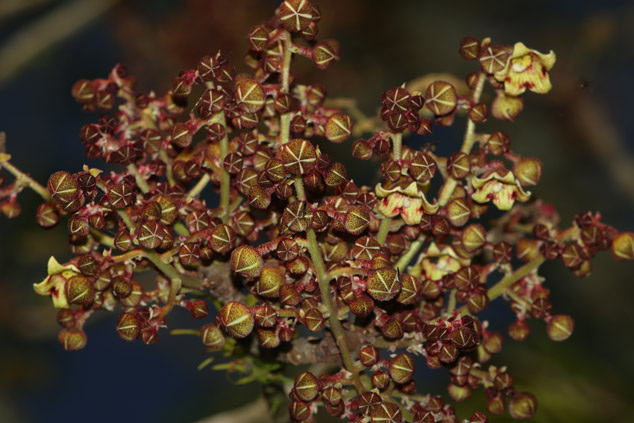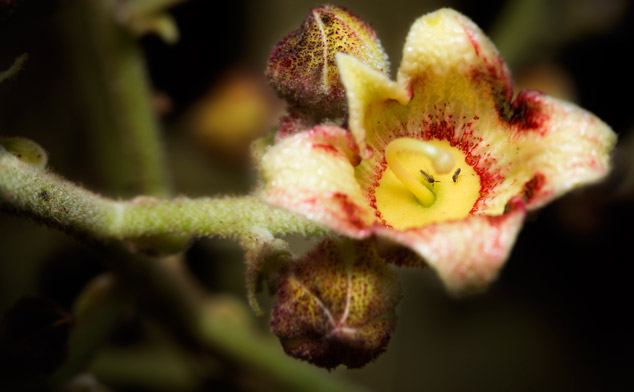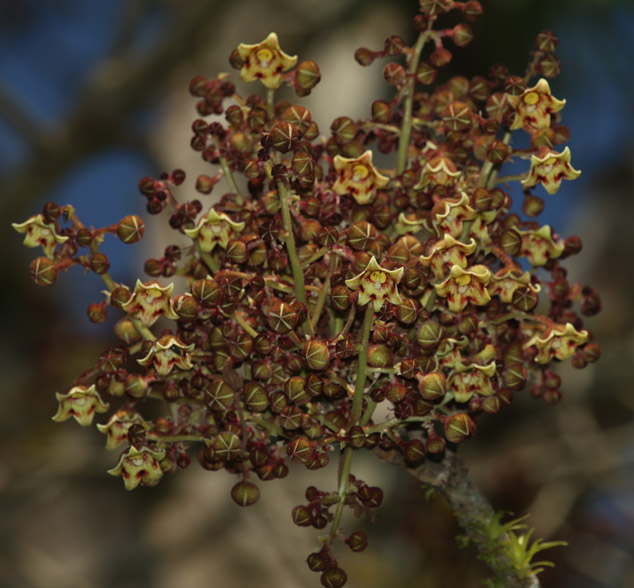Flavoring for cacao of the Aztec and Maya
The flowers of Sterculia apetala are attractive and the seed pod is a memorable size, shape, and hardness. This web page introduces this tree, it’s flowers and seed pods. Although the tree has many utilitarian uses, the one I am most interested in is as a flavoring for cacao drink of the Aztec and Maya a thousand years ago.
Sterculia apetala Castaño Flower Photo by Sofia Momzon.
The seeds can be eaten raw or cooked and provide flavor and an additional stimulant to cacao drink (http://foroantiguo.infojardin.com).
In English it is called popcorn flower
Brief description: local names
This is the national tree of Panama, so not surprisingly is named the Panama tree. The local name in Guatemala is castaño. It is also named “cacao de monte” (commercial timbers web site). Yet I see nothing whatsoever in this tree, or the flowers, or seed pods, which is even remotely similar to cacao.
We have found Sterculia apetala
- At Copan Ruinas (las Sepulturas), flowering…
- At the cloverleaf interchange of the highway from Escuintla to Monterrico, flowering about November (2012).
- At Frutas del Mundo, flowering in the month of…
Uses other than flavoring and medicinal: to make soap
Sterculia apetalaCastaño Flower Photo by Sofia Momzon.
Seeds are edible and their oil can be used in the production of a soap.
Medicinal Plant
There are thousands of Mesoamerican plants with medicinal uses. Many people might try the processed leaves of this tree to prevent hair loss (http://manualparaguias).
Living Fence from Sterculia apetala
Many tropical trees grow readily and fast from cuttings, so these are used to make a living fence. The most common are:
- Alnus jorullensis, Elsevier’s Dictionary of Trees, p. 44
- Caesalpinia velutina, near Zacapa (www.worldagroforestry.org/treedb2/speciesprofile.php?Spid=17960)
- Cordia truncatifolia, Elsevier’s Dictionary of Trees, p. 260
- Cochlospermum vitifolium, Elsevier’s Dictionary of Trees, p. 236
- Bursera species, Palo jiote, gumbo limbo
- Lonchocarpus minimiflorus, Elsevier’s Dictionary of Trees, p. 486
- Madre de Cacao
- Erythrina many species
So I was surprised to see Sterculia apetala listed as a living fence (Guerra 2009: 104).
Sterculia apetala is used to attract bees (to make honey)
Listed as a “honey plant” (USDA Forest Service” because the flowers attract bees.
Seed pod of Sterculia apetala is woody and remarkable shape
Dried seed pods are often kept as souvenirs. Here is one from the Rio Dulce area of Izabal, Guatemala.
Sterculia apetala Castaño Flower, Frutas del Mundo, photo by Sofia Monzon.
We had an opportunity to experience lots of flowers and seed pods of Sterculia apetala from Las Sepulturas, Copan Ruinas, Honduras.
Sterculia apetala (Jacq.) Karst.
Flowers February, March, April (OFI-CATIE, pages 895)
Flowers in Izabal area, Guatemala, elevation circa 50 meters, late December (2012) and early January (2013)
Flowered in Copan Ruinas, Honduras…. So it is worth noting that the flowering times we see it are totally different than the flowering times provided by respected monographs on trees.
In Panama flowers from November to March (www.ForestGeneration.com) which is closer to what we found in Guatemala.
What can be learned is no surprise: each tree, in a different eco-system, may bloom at a different time. And it is not unusual that a tree will bloom depending on the rainfall and temperature situation of that particular year (which may vary from the previous year).
Bibliography
- 2003
- Árboles de Centroamérica: un manual para extensionistas. Bib. Orton IICA / CATIE. 1079 pages.
- 2003
- Árboles de Centroamérica: un Manual para Extensionistas (Trees of Central America: a Manual for Extentionists). OFI-CATIE, pages 893-896.
- 2009
- Plantas comestibles de Centroamerica. Instituto Nacional de Biodiversidad, INBio, Costa Rica. 360 pages.
- 2009
- Historia natural del árbol Panama, Sterculia apetala (Jacq.) H. Karst. 101-106.
- 1975
- Arboles de Costa Rica. Vol. I. Centro Cientifico Tropical, San Jose, Costa Rica. 545 pages.
Most of this book is available on-line, but tree by tree. It takes a long time to get the whole opus together (and is a rather large file). In the book itself it says OFI-CATIE.
First posted March 11, 2013.
















































































